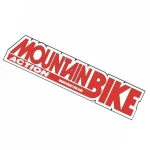TESTED: 100% S2 AND S3 EYEWEAR
Is the S2 or S3 sunglass right for you?
With deep roots in motocross, 100% has been making a big splash in the world of cycling. While 100% makes a variety of protective equipment, the company also strives to produce high-performance eyewear. The wrecking crew has been testing two of 100%’s top-selling sunglasses—the S2 and S3.
Tech features:
Both of these sunglass models take cues from the Speedcraft model, which is also part of 100%’s lineup. The top section of the S3’s frame is almost identical to that of the S2’s. Where they differ is in the lower nosepiece and the shape and coverage of the lenses. The lower section of the S3 can be removed and replaced as a separate piece, while the S2 has a bridge from the top of the frame that connects down to the padded nose portion.
The frames are made with Grilamid TR90. This is a popular material for sunglass frames because this polymer has long-term resistance to UV rays, which keeps the frame colors from fading. Most important, this material is less likely to snap or break on impact and will absorb shock. Both frames use ultra-grip rubber for the nose pads and at the tips of the arms to help the glasses stay on the rider’s face. These rubber grippers also hold the glasses where they need to be if they get wet or covered in sweat.

Different conditions call for distinct lenses, and this is where the vision (literally) of 100% comes to life. The company offers contrast-enhancing HiPER lenses, mirror finishes, and a variety of VLT (Visible Light Transmission) optics and photochromic lens options. All lenses from 100% also feature Hard Coating protection, but this isn’t only for scratch resistance. 100% claims this also bumps up the level of impact protection. Each lens is also ANSI (American National Standards Institute) compliant when hit. Instead of cracking or shattering, the flexible polycarbonate material bends to soak up any big hits all while keeping your eyes safe. The last coating that we see 100% utilizing is a hydrophobic and oleophobic treatment. This helps repel dirt and oil from mirror-finished lenses.
All of 100%’s Sports Performance line includes a hard case, a microfiber bag that can also be used to wipe off the lens, a narrower-fit nose pad than the one already on the glasses, and a clear lens. The hard case can store the sunglasses with a lens already installed, plus the included clear lens that slips into a precut holder. What’s more, there is an additional slot to hold a third lens if a rider so chooses. The lenses start at $30 for the clear ones, $60 for the HiPER models, $50 for the mirror options and $170 for the Photochromic choices.
Field test results:
We kick off our field test with our thoughts on the lens technology and how it performs, since both glasses have the same class of options to swap in and out. Hands down, 100%’s HiPER lenses are our favorite for sunny conditions. They do their job by boosting contrast and enhancing details on the trail. It’s not that the mirror options are bad by any means, but the details and color enhancement of the HiPER lenses cannot be matched. If low light and heavily shadowed woods with a few bright spots on the trails are your typical conditions, the clear lenses are useful, but we found ourselves going with the HiPER Coral lens to have the best of both worlds. They are not ideal for full-sun conditions, but they are a good in-between to use instead of the smoke and clear lens choices.

The S2 is not as large and therefore does not offer the same amount of coverage as the S3. Both sit in a similar position at the brow, but the S3 extends back farther down and over the cheekbones. We found that our test riders with smaller faces preferred the fit and coverage of the S2. The arms fit under most helmets, but it’s worth noting that we have been seeing a growing wave of extended-coverage, half-shell helmets that can sometimes interfere with certain sunglasses. The frames will either hit the top of the helmet’s face opening, making annoying clicks while riding, or the arms will not have proper clearance. In terms of airflow, the S2 was the winner. With less face coverage on the side of the S2 sunglasses, air could escape more easily. Some riders experienced fogging near the nose and eyebrows with both the S2 and the S3, but as soon as we got moving, both would clear right up. Both models are so close in weight, with only a 2-gram difference, that few will notice. Overall, our test riders kept picking up the S2 rather than the S3 sunglasses. Whichever model you go with, there will likely be no disappointments, and they will only enhance your mountain biking experience.
HITS:
• Great lenses
• Sturdy, long-lasting frames
MISSES:
• Pricey (but worth the money)
• Minor fogging issues for some riders
STAR RATING: ★★★★½
Weight: 34g w/ lens, S3; 32g w/ lens, S2
Colors: 14 frames and 7 lenses, S3; 12 frames and 13 lenses, S2
Lens types: HiPER, mirror, photochromic, low light and clear
Price range: $155–$210
Contact: www.100percent.com




